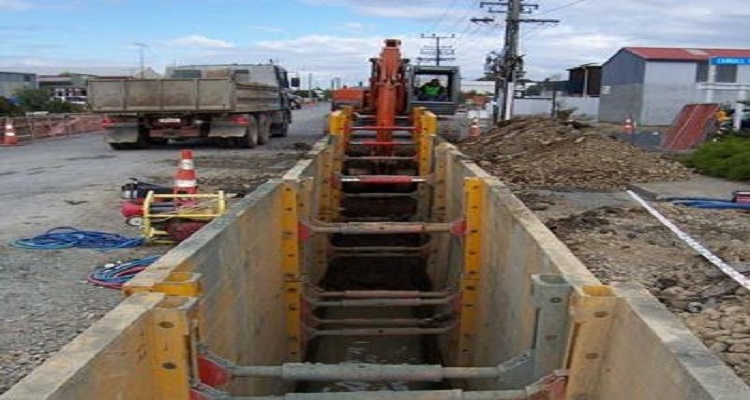Below is excavation swms safe work method statement for performing the excavation work for different purposes like piping, service trenches, manhole and cable laying including building construction work etc.
The procedure is given in main steps and other considerations must be kept in the view.
This method statement covers general excavation works for foundations and other structures requiring straightforward excavations. It generally encompasses the following:
- Machineries for earthwork, delivery, transportation, handling and storing at site.
- Survey
- Stockpiling and disposal of excavated material
- All necessary safety measures
- Testing, preparing ground surface to final grade and levels
Project Manager is responsible for overall project execution, quality and safety. He will adopt a leading role with respect to contractor’s quality and safety procedures.
The PM is responsible for the overall implementation of this method statement.
Project Manager shall ensure that the key personnel are well aware of the relevant specifications, standards, regulations and method statement.
Necessary Equipment and Tools
Below is the equipment involved in the subject works included the following:
- Excavator
- Power shovel
- Motor Grader
- Dump Truck
- Plate and Roller Compactor
- Front End Loader
- JCB
- Water Tanker
- Hand tools (Shovels, Spade, rake etc.)
- Dewatering Equipment (if required)
- Total station, level
- Shoring materials (if required)
The capacity / size and quantity of the above equipment shall be judged in accordance with site conditions, requirements, and availability at the time of execution.
HSE Requirements
- Site HSE Management shall be applied as per project HSE plan.
- All personnel involved will use necessary PPE as required such as safety helmet, glasses, coverall, shoes, gloves, ear plugs etc.
- HSE officer to ensure that excavated area is barricaded. Adequate warning tapes and warning signs are provided. All access from adjacent play ground/park/public area shall be closed and monitored.
- Hazard analysis and risk assessment for excavation activities must be prepared where all major possible risks/ hazards are highlighted.
- The workers will be made aware of safety requirements related to this activity through daily tool box and safety talk.
- All required work permits will be acquired and kept available at respective work site hanged clearly in plastic folders.
- Safety notice board will be installed at the project site.
Pre Requirements
Ensure all clearances from the concerned government departments are obtained before starting the trenching and excavation work.
Selected working area should be barricaded to avoid accidents & damages.
Verify location of survey monuments in the area in which work is to be executed. If any disturbance due to excavation work is applicable, correct restoration to be done properly.
Mark required area to be excavated & locate the building limits with enough space for open cut excavation.
Clear / remove from site any obstructions to excavations, establish & maintain accurate lines & levels as required, provide batter boards, line stakes & templates & establish permanent reference lines & benchmarks as required.
Ensure suitable access / safe ramps provided for the safety of all site personnel’s, proper safety and PPE requirements to be followed.
Place signage such as Keep Out, Excavation is going on and Exclusion Zone.
Physical barrier to be erected around the excavation area where it is appropriate.
Excavation Procedure
Excavation will be carried out to the lines, grades and levels as per the substructure requirements & level shall be checked at intervals to confirm with the drawings.
Excavation level for the determination of soil improvements must be based on Soil Investigation Report by Third Party Testing Laboratory.
Excavation procedure should be considered in Sloping, Common & Deep Excavation Areas with Proposed Shoring lines as per detailed in the Excavation Drawing Plan.
Excavation support system if needed shall be provided as per requirements & dispersion of dust shall be minimized during excavation work by suitable means.
Excavated material shall be stacked and removed from the working area in proper manner & to be hauled away to the approved designated disposal area.
Disposal areas are as Follows:
- For Soil – As per Municipality Instruction
- For Concrete – Waste Management Recycling Area
Ensure excavated area is free of water by bailing, pumping or provide dewatering drainage system if required.
Keep bottoms of excavation clean & clear of loose materials, level stepped at changes of level except excavations made by drainage for slope purpose if required.
If removal of earth causes displacement of adjacent earth, remove disturbed earth as necessary.
Final excavation surface shall be levelled and well compacted to the specified level of compaction and the soil at the level of foundation should not be disturbed.
The bottom of all excavated areas shall be trimmed, leveled and rammed.
While excavation is in progress, excavation area foreman will continuously monitor the level to avoid over excavation.
The surveyor will check the lines & levels upon completion of excavation.
Upon acceptance of survey, the area will be released for subsequent activities.
If excavation goes below the adjacent structures, shoring will be provided.
Ensure that the area to be backfilled is clean from any debris wooden or other materials.
Inspection request to be raised, inspected & approved by concerned persons/authorities.
